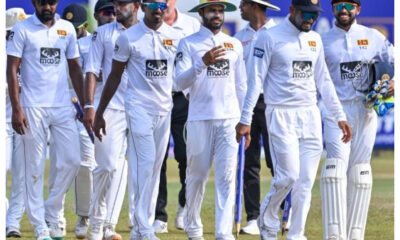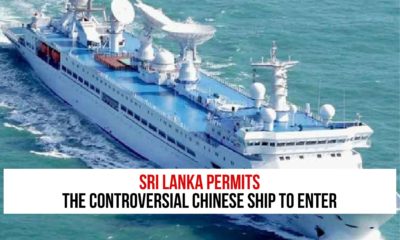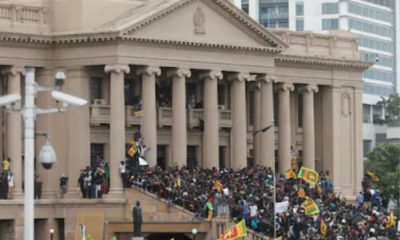News
The IMF agreement with Sri Lanka won’t change the course of a collapsing economy.
Published
1 year agoon

Without a large “haircut” on its external debt and a dramatic course correction in its economic direction, the nation will probably be pleading for another IMF agreement. In a few years, it might experience a new default.
Without a significant “haircut” on its external debt and a significant change in its economic track, the country will likely be appealing for another IMF loan. It might encounter a new default in a few years.In actuality, a crumbling economy will not be stopped by the IMF agreement or the minimal monies that will be released in installments.
Due to Sri Lanka’s impending default on its foreign debt in April 2022, it is likely that the process of restructuring its debt, which aims to lower the country’s unsustainable debt levels, may take months or perhaps years.
Read Also:- Vande Bharat Express Train New Route Delhi-Jaipur-Ajmer
In fact, Sri Lanka will probably be pleading for another IMF agreement if its economic trajectory does not significantly change and if its external debt does not receive a big “haircut” (a decrease of future interest payments or a portion of a bond payment that will not be returned). In a few years, it might experience a new default.
The agreement is predicated on the same hypotheses and expectations that are grounded in the free market system. The problem for Sri Lanka, however, is not to reenter the choppy waters of the world economy. Instead, the nation must find ways to expand domestic production of the necessities that its citizens depend on to survive. This includes improving the local agriculture sector to support the food chain.
The IMF agreement with Sri Lanka.
In fact, Sri Lanka will probably be pleading for another IMF agreement if its economic trajectory does not significantly change and if its external debt does not receive a big “haircut” (a decrease of future interest payments or a portion of a bond payment that will not be returned). In a few years, it might experience a new default.
The IMF agreement is predicated on the same hypotheses and expectations that are grounded in the free market system. The problem for Sri Lanka, however, is not to reenter the choppy waters of the world economy. Instead, the nation must find ways to expand domestic production of the necessities that its citizens depend on to survive. This includes improving the local agriculture sector to support the food chain.
Political and economic situations
The primary budget deficit, which is the difference between government revenue and expenditure, and the current account deficit, which is the difference between foreign earnings and expenditure, are at the root of the issue.
The drastic contraction of the economy in 2022 can already be seen as a result of the austerity measures that the IMF has advised be implemented in order to attain a primary budget surplus target for 2024.
Gross domestic output (GDP) in Sri Lanka fell 12.4% in just the fourth quarter of 2022. Yet, the external balance saw a $154 million surplus over the same quarter. This was largely brought about by the prioritisation of imports, which the country’s rulers had shunned for years due to the ideological
Future economic recovery efforts should concentrate on local investment and production while managing the foreign sector. Nevertheless, the opposite policies are being implemented as a result of the IMF’s emphasis on a primary surplus and a free market system. The people are suffering a great deal as a result of this tactic.
Free trade’s “straitjacket” strategy draws in foreign investment, which includes a resumption of borrowing on global capital markets. But wasn’t it one of the primary reasons Sri Lanka’s economy initially went into a crisis?
High-interest loans and capital inflows supported by debt were paid off by Sri Lanka using the nation’s labourers’ own hard-earned foreign currency. And that debt was used to purchase expensive real estate and inefficient infrastructure.
So, if Sri Lanka sticks with the conventional crisis-fighting strategy, there won’t be much opportunity for alternatives.
Additionally, with real incomes sharply dropping, how can the state collect taxes? How on earth can an already unpopular government afford to tax a pie that is getting smaller?
Unavoidably, the current strategy for fiscal consolidation will encounter a barrier. In fact, a fire sale of public assets and severe wage suppression appear to be the concealed goals of the ruling elite. Importantly, millions of individuals have fallen into poverty as real incomes have fallen sharply. Also, the sale of public assets to foreign companies will bolster the treasury’s finances and bring in foreign money that can be utilised to settle international debt. Yet, a significant political backlash will undoubtedly result from this double tactic.
The effects of a destabilising economy were already evident in Sri Lanka last year. President Gotabaya Rajapaksa was overthrown as a result of the nation’s economic problems, severe shortages of necessities, and price increases. In terms of a broad base of support, the administration of Ranil Wickremesinghe does not possess any advantages over that of its predecessor.
Yet, Wickremesinghe and the elites he represents seem content to keep doing the same thing.
Even worse, they oppose holding elections at all, knowing full well that they will lose. Instead, they are placing their hopes in additional pledges of foreign aid and investment, hoping that the public would be appeased by such declarations.
Redistribution, cutbacks, and wealth taxes
There is little doubt that the aforementioned course would end in disaster, but coming up with alternatives requires a grasp of Sri Lanka’s historical background and current place in the world.
Many commentators had discussed using lessons from other countries’ debt restructuring when Sri Lanka made its first financial default in history last year.
Consider the 1980s South American debt crisis as an example. It would seem that Sri Lanka would go through the same structural adjustment process. But during the decade of hyper-globalization in the early 1990s, the debt-stricken nations of Latin America were integrated into the growth of global trade, even though it came at a high social cost and had long-term effects on inequality in their own societies.
The economic crisis in Sri Lanka, however, came at a time when global growth was declining.
Although commerce saw a brief comeback during the COVID-19 epidemic, the long-term trend of falling trade growth is still present and is being exacerbated by geopolitical tensions. As a result, it is necessary to consider solutions for debt sustainability as well as export-oriented growth potential in light of the current global situation.
The Wickremesinghe-Rajapaksa administration claims that the country’s economic crisis was caused by tax cuts implemented by the previous administration in 2019. They go on to say that this has to be revoked.
You may like
-


Former cricketer Muttiah Muralidharan of Sri Lanka plans to spend ₹1,400 crore in Karnataka
-


Ireland lost to Sri Lanka by 280 runs and an innings
-


Sri Lanka scored 305 runs against New Zealand
-


Sri Lanka permits the controversial Chinese ship to enter, India is concerned
-


All-party meeting called Centre government to discuss Sri Lanka crisis

